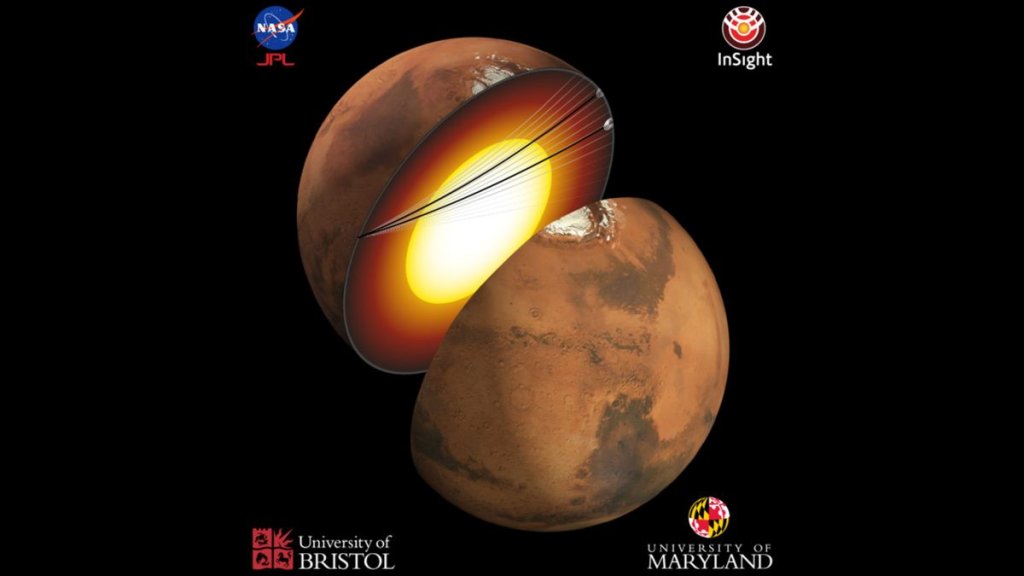
Seismic waves inside Mars’ core hint at how it became hostile to life (Image Credit: Space.com)
Seismic waves have been observed traveling through the core of Mars for the first time, revealing details of the composition of the Red Planet’s heart.
The results may suggest why Earth can support life but its neighbor, Mars, cannot. The seismic data was collected by an international team of researchers using NASA’s InSight Mars lander and it reveals the Martian core to be composed of a completely liquid iron-alloy core with high percentages of sulfur and oxygen.
Related: Scientists hail scientific legacy of NASA’s Mars InSight lander
This grants a better understanding of how Mars formed in the infant solar system around 4.6 billion years ago and illustrates some of the key geological differences between the Red Planet and Earth. These differences may ultimately help explained why our world was able to remain habitable while Mars was reduced to an arid and barren landscape.
“In 1906, scientists first discovered the Earth’s core by observing how seismic waves from earthquakes were affected by traveling through it,” research author and University of Maryland (UMD) Associate Professor of Geology Vedran Lekic, said in a statement. “More than a hundred years later, we’re applying our knowledge of seismic waves to Mars. With InSight, we’re finally discovering what’s at the center of Mars and what makes Mars so similar yet distinct from Earth.”
To assess differences between our planet and Mars, Lekic and the team specifically tracked how two seismic events on Mars progressed. The first was a large Marsquake, the other was a massive impact by an object from space that sent seismic waves rippling through the Martian core.
The seismologists and planetary scientists looked at how long it took these seismic waves to travel through the core in comprising with other waves that stayed with the Martian mantle, the solid bulk of the planet above the core.
Combining this data with other seismic and geophysical measurements, the researchers were then able to estimate the density and compressibility of the material through which the waves traveled. This indicated that Mars probably has a completely liquid core, differing from the core of Earth which has a solid outer part and a liquid inner component.

The team was also able to determine some of the chemical elements that compose the Martian core finding evidence of a surprisingly large proportion of light elements such as sulfur and oxygen in its innermost layer. Earth’s core has a much lower percentage of light elements implying that the core of Mars is much less dense than the core of our own planet.
This could indicate that the two neighboring planets experienced different formation conditions.
“You can think of it this way; the properties of a planet’s core can serve as a summary about how the planet formed and how it evolved dynamically over time. The end result of the formation and evolution processes can be either the generation or absence of life-sustaining conditions,” UMD Associate Professor of Geology and research author, Nicholas Schmerr, explained. “The uniqueness of Earth’s core allows it to generate a magnetic field that protects us from solar winds, allowing us to keep water. Mars’ core does not generate this protective shield, and so the planet’s surface conditions are hostile to life.”
Traces of magnetism in the crust of Mars indicates that the Red Planet did once have this magnetic shielding that would have protected the complex molecules needed for life from harsh solar radiation that would break them apart. The researchers think that Mars may have gradually evolved into the planet we see today transforming from a habitable environment to one hostile to life. And the team thinks that the interior of the planet and the bombardment of space rocks across its surface may have played a key role in this evolution.
“It’s like a puzzle in some ways,” Lekic said. “For example, there are small traces of hydrogen in Mars’ core. That means that there had to be certain conditions that allowed the hydrogen to be there, and we have to understand those conditions in order to understand how Mars evolved into the planet it is today.”
Not only have the results reached by the team helped to confirm models of the interior of Mars, but they point the way for future geological investigations of other solar system planets including Earth’s other neighbor, Venus, and the closest planet to the sun, Mercury.
“This was a huge effort, involving state-of-the-art seismological techniques which have been honed on Earth, in conjunction with new results from mineral physicists and the insights from team members who simulate how planetary interiors change over time,” Bristol University senior lecturer and study first author, Jessica Irving, said. “But the work paid off, and we now know much more about what’s happening inside the Martian core.”
The results will be somewhat bittersweet for followers of the InSight mission, which set down on the Martian surface in November 2018 with the mission of “taking the vital signs” of Mars including the planet’s pulse in the form of seismic waves traveling through it and its temperature.
After around 130 days on the Red Planet, in 2019 InSight made history by measuring the first recorded Marsquake. The InSight mission ended at the tail end of 2022.
“Even though the InSight mission ended in December 2022 after four years of seismic monitoring, we’re still analyzing the data that was collected,” Lekic concluded. “InSight will continue to influence how we understand the formation and evolution of Mars and other planets for years to come.”
The team’s research was published on April 24 in the journal Proceedings of the National Academy of Sciences.
Follow us @Spacedotcom, or on Facebook and Instagram.





